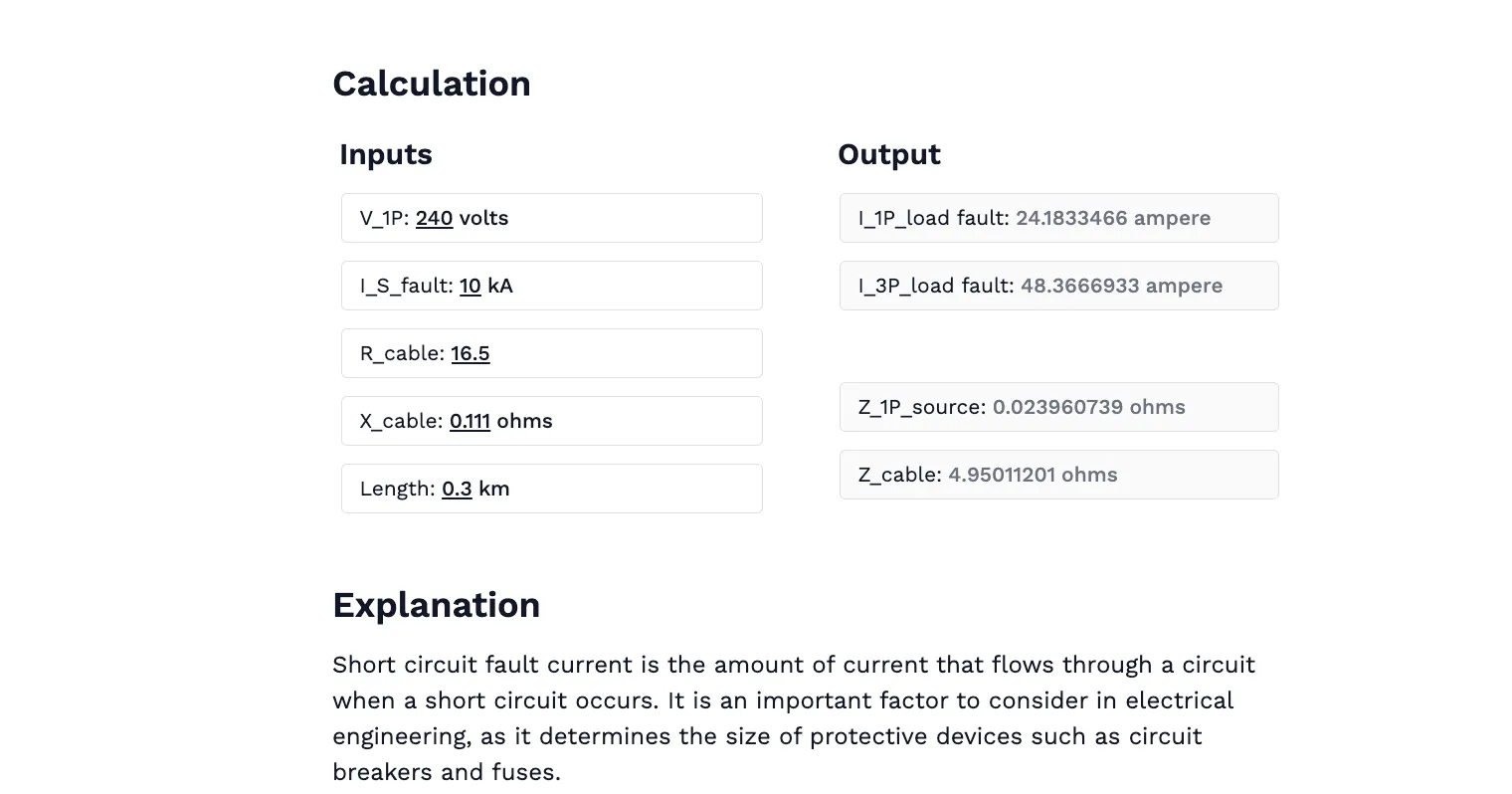Free Short Circuit Current Calculator to AS/NZS 3008. Step-by-step, engineering-grade tool with downloadable report.

This template is not available yet. You can sign up and create it yourself!
Or let us know if you'd like to be notified when it’s ready:
About this Short Circuit Current Calculator
Cable Short Circuit Current Calculation tool helps you calculate the fault current flowing through a cable by taking into account key parameters such as Voltage (V), Single Phase or 3-Phase current, Source fault current (kA), Cable size, Cable length, Cable impedance, and insulation type including PVC cables. All calculations are based on AS/NZS 3008 and AS/NZS 3000:2018 standards to ensure compliance. Current is measured in the unit of ampere (A), while voltage is measured in volts (V). Fault current is typically expressed in amps (A), and apparent power in AC systems is measured in kVA.
This calculator is for:
- Electrical engineers designing and verifying cable installations for fault conditions.
- Contractors assessing cable suitability for specific installations, ensuring safe operation under fault scenarios.
- Students and educators studying or want to learn more about short circuit current calculations and cable performance.
The tool allows for quick feasibility checks to compare different cable sizes, lengths, and fault current conditions, helping you ensure that the installation meets safety standards and can handle expected fault currents. Alternative approaches to this calculation, including manual methods, can be found in textbooks such as Short-Circuit Currents in Power Systems by Ismail Kasikci and Electrical Power Systems by C.L. Wadhwa, which provide further details and technical tables for manual calculations. When performing short circuit current calculations, transformer parameters and secondary voltage are also important factors to consider.
Key Aspects of a Short Circuit Current Calculation

Short Circuits
A short circuit occurs when electrical current takes an unintended path with minimal resistance, often bypassing the normal load in a circuit. This sudden surge in circuit current can result in dangerously high fault current, posing significant risks such as equipment damage, fire, or even personal injury. The ability to accurately calculate short circuit current is essential for determining the correct cable size, selecting the appropriate conduit type, and ensuring that all components can safely withstand fault conditions. Key factors that influence the magnitude of a short circuit include cable impedance, source impedance, and the resistance of the cable itself. By understanding these elements, engineers can design circuits that minimize the risk of faults and ensure reliable, safe operation of electrical systems.
Cable Characteristics
The characteristics of a cable play a crucial role in how it responds to fault conditions and determines the flow of short circuit current. Important properties include the conductor size (measured in mm²), material (such as copper or aluminum), and the type of insulation—commonly PVC or elastomer. The number of conductors, whether single core or multi core, also affects the cable’s overall impedance and resistance. For example, single core cables may have different heat dissipation and impedance values compared to multi core cables. The cable’s construction, including the arrangement of conductors and the thickness of insulation, impacts its ability to carry current safely during a fault. Selecting the right cable size and type ensures that the cable can handle the expected fault current without exceeding temperature limits or compromising safety. Reference tables in AS/NZS 3008 provide detailed values for cable impedance and resistance, helping engineers choose the most suitable cable for each installation.
Fault Current Calculation
Calculating fault current is a fundamental step in electrical design, ensuring that cables and protective devices are properly rated for safety and compliance. The process involves using the following formula:
Fault Current (Iₓ) = Source Fault Level (kA) × (Source Impedance / (Source Impedance + Cable Impedance))
Key inputs for this calculation include the cable length, cable impedance (Zc), source fault level (in kA or amperes), and the system voltage (V). The cable run distance directly affects the total impedance, as longer cables increase resistance and reduce the fault current. Using a fault current calculator or reference tables from AS/NZS 3008, you can determine the expected fault current at any point in the installation. For example, in a 3 phase system with a 100m cable run, 400V supply, and a source fault level of 10kA, the calculated fault current will depend on the measured cable impedance and the total resistance of the conductors. This calculation helps you check if the selected cable and protective devices (such as fuses) are adequate for the installation, ensuring compliance and safety.
Power Factor Considerations
Power factor is an important parameter in short circuit current calculations, especially in three phase and single phase systems. It represents the phase difference between voltage and current, and can influence the magnitude of the calculated fault current. A lower power factor means more reactive components in the circuit, which can reduce the actual fault current flowing through the cable. When calculating short circuit current, it’s essential to use the correct power factor values as specified in AS/NZS 3008, as this affects the selection of cable size and the rating of protective devices. Accurate consideration of power factor ensures that the cable and installation can safely handle both normal and fault conditions, maintaining system reliability and safety.
Cable Installation and Safety
Proper cable installation is vital for ensuring safety and compliance with AS/NZS 3008 standards, particularly under fault conditions. The choice of cable size, conduit type, and installation method all impact the cable’s ability to withstand short circuit currents. Factors such as the length of the cable run, the environment (industrial spaces, confined areas), and the distance between protective devices and load points must be considered. Using the correct cable size and ensuring secure connections help prevent overheating and reduce the risk of fire during a fault. Additionally, installing appropriate protective devices like fuses or circuit breakers at strategic points in the circuit provides an extra layer of safety. Regular checks and adherence to installation guidelines ensure that the entire system remains safe, reliable, and compliant with regulatory requirements.
Engineering templates
Common calculators
Design guides
FAQs
What factors influence the short circuit current in a cable?
The short circuit current in a cable is influenced by factors such as the source fault current, cable impedance, cable size, and cable length. The transformer's secondary voltage and kVA rating are important factors in determining available fault current, as they directly affect the amount of current that can flow during a fault.
These factors determine how much current, measured in the unit of ampere (A) and often referred to as amps, will flow through the cable during a fault condition. In some cases, standard tables are used to find values for calculations, such as reactance or cable ratings, to ensure accuracy.
Why is it important to calculate short circuit current for cables?
A short circuit calculation of the current ensures that the cable is properly rated to handle fault conditions without overheating or causing damage to connected equipment. Calculations should always consider the worst-case fault scenario to ensure maximum safety. It also ensures compliance with safety standards like AS/NZS 3008.
For more details, check the relevant standards to learn more about cable safety.
How does cable impedance affect short circuit current?
Cable impedance limits the fault current that flows through the cable, which is measured in the unit of ampere (A), commonly referred to as amps. The amount of fault current depends on the impedance and the voltage applied (measured in volts). Higher impedance reduces the fault current (amps), while lower impedance results in higher fault currents, impacting the cable’s performance and safety. In some cases, the type of insulation, such as PVC cables, can affect the impedance values. The physical space between cables can also influence heat dissipation and impedance. Standard tables are used to find impedance values for different cable types and installation scenarios.
Learn about the benefits of using CalcTree on engineering projects!


